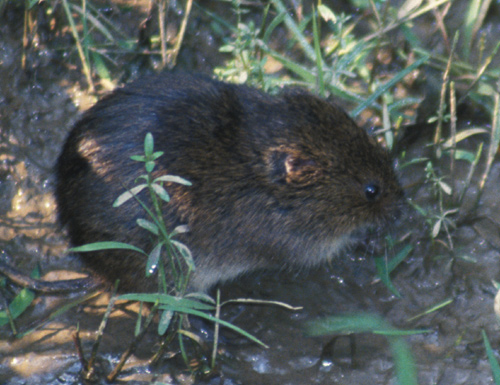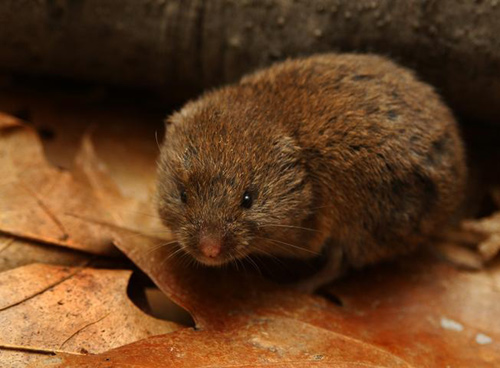Voles are small rodents very common in Connecticut. Two of the species found in the state are: Meadow Voles, also called Meadow Mice or Field Mice, and Woodland Voles, often called Pine Voles. The Meadow Vole is the most abundant species in the state. Both voles are small with stockier builds than mice. Both have brownish-furred bodies with lighter fur on their undersides.
Meadow Voles have more color variety and may have fur ranging from yellowish to blackish brown. They have a long tail 1 to 2 1/2 inches long. They are the slightly larger vole of the two weighing 1/2 to 2 1/2 oz.
Woodland Voles tend to be more reddish brown than Meadow Voles. Woodland Vole tails are shorter at 1/2 to 1 inch long, and these voles weigh 1/2 to 1 1/2 oz.
Meadow Voles range through the northern third or so of the US and up through Canada. Woodland Voles range through the eastern section of the US except for Florida and Maine. As their names imply, Meadow Vole habitat consists of open areas such as fields, lawns, marshes and glades while Woodland Voles prefer (but are not limited to) a wooded setting with a layer of dead leaves on the ground. The Meadow Vole is far more likely to be a yard pest. Both voles are active all year round and at any time during the daytime or nighttime.
Voles make systems of shallow tunnels and nest in underground chambers. Often, especially for the Meadow Vole, the passages are runways on the surface through the grass or other groundcover. Meadow Voles may also make summer nests in a surface spot under the cover of vegetation. In the winter these rodents are active in the space between the ground and snow cover, making extensive tunnels under the snow blanket. Nests may be built on the ground surface under snowcover during this time of the year. Voles often travel in existing mole tunnels as well as in ones they dig themselves.
Voles are herbivores. These are the pests that eat the roots out from under your garden plants. They eat grass, clover, leaves, shoots roots, tubers, and flowers, favoring the tenderest parts. They also eat bark, especially that of fruit trees. This can seriously damage a tree. Trees move the sugars and carbohydrates made by photosynthesis in the leaves through the inner bark (the phloem). If the bark is removed 360 degrees around the trunk, a tree cannot transport its food and will die.
Little voles are mammals eaten by almost every carnivore. They have evolved to reproduce at a great rate because so many of them are eaten.
Meadow Voles in Connecticut will breed at any time of the year except at the peak of winter in January and February. They can produce 5 to 12 litters a year, one captive specimen produced 17. Meadow Voles exhibit population cycles. Every 3 to 4 years an unusually high number will be produced. Damage to yards and gardens often increases during these peaks.
The Woodland Vole does not breed as often, their season goes from late March to September with only 1 to 4 litters produced a year. The Woodland Vole also does not exhibit the population cycles observed for Meadow Voles.
Other Connecticut VolesThe Southern Red-backed Vole, Clethrionomys gappen is another common Connecticut vole species that favors moist wooded habitat or swampy areas. These voles do not create extensive tunnel systems, but use existing burrows.
Neat Facts
The Meadow Vole is believed to have the highest reproductive rate of any mammal in the world. Females can breed when they are as young as one month old. Gestation takes only 3 weeks and litters contain 3 to 10 pups. In warmer climates the breeding season can last all year round.
In spite of one of its common names, Pine Vole, and its Latin name, Microtus pinetorum, the Woodland Vole is only commonly found in pine woods in some southeastern states.

